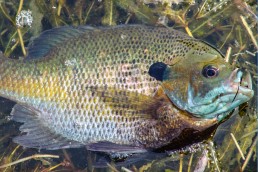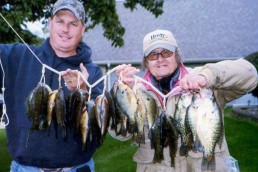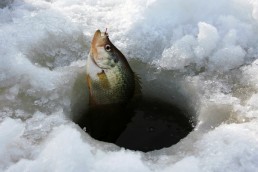SHARE THIS POST
Without a doubt, ounce for ounce the bluegill is one of the most “fighting” fish in Iowa and the Midwest. For its size, the hooked bluegill will put an angler through paces with its sideways slicing motion. It has always amazed me to watch a nice-sized bluegill on the end of my line putting up such a great fight. It’s a thrill an angler will never get tired of.
Right now on our lakes and rivers that contain bluegills, you can go out and enjoy some great angling for these colorful beauties. When heading out to your favorite location, the type of area you fish will make all the difference in your success. You are going to want to search out areas that contain bull rushes or standing reeds.
You will find that most areas like this will contain other vegetation like lily pads and underwater weeds like cabbage weeds. You may not find all in one spot, but look for a combination, if possible. The weeds that you decide to fish will be a good indication as to just what kind of bottom makeup you are fishing. For example, reed beds will prefer harder, sandy-type bottoms to grow, whereas lily pads may be found on waters with somewhat softer types of bottoms. By knowing the bottom makeup you are able to determine which locations will be high-percentage areas for holding those big bluegills.
You will need a minimum of terminal tackle: A long, light-action rod or an ultralight rod, a small spinning reel spooled with a good quality 2- or 4-pound-test line and a good assortment of small hooks, jigs and some split shot will do. Along with this, it’s a good idea to have an assortment of small floats to suspend your bait. As you can see, not too much tackle is required.
You are going to want to use some type of larvae bait. You can use baits like spikes, which are maggots, mousies, which are a small larvae bait with a tiny tail, or use waxworms. If you opt for waxworms, use smaller ones for the best results. Bluegills have tiny mouths and the smaller baits seem to work better.
After rigging your line with either a small jig or a plain hook, simply attach a small float to your line, attach the bait of choice and you’re ready to go. Initially, set your bait approximately 1 foot to 2 feet down into the water. This is just a starting point; you can adjust as needed. Now, lightly cast your presentation to the edges of the bull rushes and let your bait sink. Most bluegills will come out from just inside these edge areas to take your bait. Watch the float carefully so that you can spot those light-biters. Sometimes they will hit very hard and drag the float down, while other times they will seem to play with the bait gently before taking it. You will learn after a few bites when to set the hook.
Are you enjoying this post?
You can be among the first to get the latest info on where to go, what to use and how to use it!
Speaking of setting the hook, just use a nice, firm wrist hook-set. It is not necessary to yank back hard. Again, these fish have small, soft mouths and you will just pull the hook loose and possibly injure the fish.
If you’re really looking for some fun, tie on a double-hook rig to your line and fish it the same way as described. The fun with a double-hook rig is that when you hook two big bluegills at once, each fish will have a mind of their own as to where they are going. Do this with light tackle; it’s a thrill. This double-hook rig is excellent to use once you have located a good-sized school of bluegills.
One last thing that I want to mention is that when looking for these feisty fish, it is a great time to take the whole family out to enjoy the fast action. Bring mom and the kids along and I guarantee you will make some memories to last a lifetime. And don’t forget the camera, as you’ll be glad you brought it along to record the smiles.
Email your outdoors questions to Mike Cyze at: lastcast13@yahoo.com. You can also check out his blog at: lastcastoutdoors.com or listen to him on ESPN Radio.
MWO
SHARE THIS POST
Did you enjoy this post?
You can be among the first to get the latest info on where to go, what to use and how to use it!
Mike Cyze
Mike Cyze has been called one of the most knowledgeable multispecies river anglers in the country. His ability to catch fish under the challenging conditions encountered in the river environment, combined with his overall fishing knowledge, has earned him recognition as a true Mississippi River Expert. Contact him at: lastcast13@yahoo.com.



